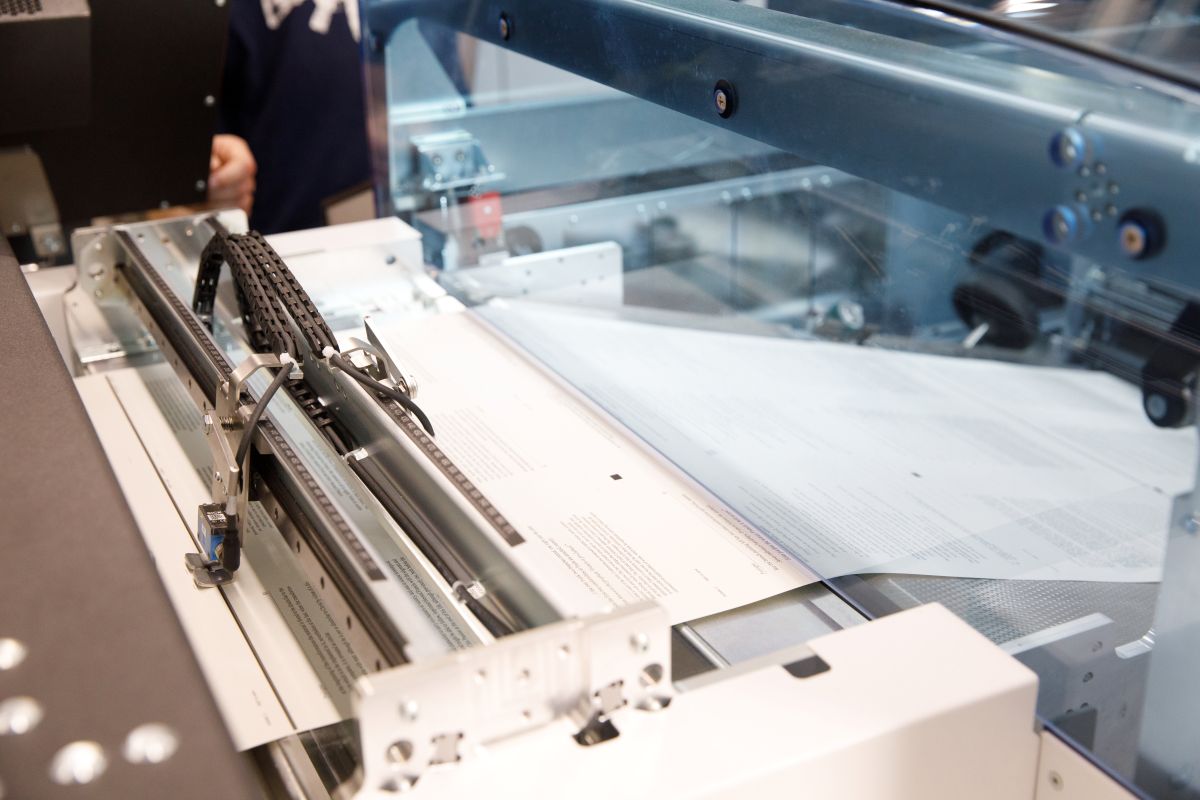

For much of human history, printing technology has been evolving, giving us more advanced and efficient ways to produce books and other printed materials. From the very first hand-written scrolls to the fully computerized presses we know today, printing technology has allowed humans to record and share stories, information and communication for thousands of years.
More recently, the printing industry has shifted its focus to advancing digital inkjet printing technology. Digital inkjet printing is a method of printing where digital files are used to control inkjet nozzles that spray ink directly onto a material, without the need for physical printing plates. By eliminating plates, digital inkjet enables on-demand printing with high levels of customization and flexibility.
How Digital Inkjet Printing Works
Similar to offset printing, setup is a crucial aspect of achieving a successful digital inkjet print. Proper design and file formatting help ensure that the final product delivers crisp images and vibrant colors. The computerized press reads the digital print files to control its inkjet heads, which use tiny nozzles to precisely spray ink onto the desired substrate (typically paper). After printing, the ink is cured using one of several drying methods – heat and UV curing are two of the most common methods.
Common Uses of Digital Inkjet Printing
While traditional offset printing methods that use laser-etched plates remain highly viable in 2025, there are several key scenarios where digital inkjet printing offers a more efficient and flexible solution.
- Short-run printing: Ideal for small orders, such as a magazine with low circulation or a niche book project. A major advantage of digital inkjet printing over offset printing is its minimal setup costs, making short printing runs more financially practical than offset.
- Variable data printing: Digital inkjet printing allows for easy customization of text, images and offers on printed materials. For example, names or addresses can be personalized on each printed piece – quickly and accurately – without slowing down production.
- Print-on-demand: Perfect for fully customized, lower quantity projects like personalized books or marketing materials. On-demand printing helps reduce waste and storage costs by printing only what you need, when you need it.
Digital Inkjet vs. Offset Printing
There are several key differences between digital inkjet printing and offset printing. These differences lie in the pre-press process, how the presses function and the use cases for each method.
Plate Preparation: Offset requires creating physical printing plates, while digital inkjet is plate-less. The plates used in offset printing are typically aluminum and laser-etched to match the customer’s design files.
Setup Time: Digital inkjet has significantly shorter setup times, making it ideal for short runs and quick turnarounds. Offset, on the other hand, requires a greater time and material investment during the setup process due to the need for printing plates.
Flexibility: Digital inkjet printing offers greater flexibility for customization and variable data. Once the plates are created and an offset print is set up, it’s difficult to make any further changes or customizations.
Sustainability: One benefit of digital inkjet printing is its efficient use of paper. Compared to offset printing, digital inkjet typically generates less waste due to fewer make-ready sheets and lower spoilage rated during setup and production. It also eliminates the need for physical printing plates, further reducing material use, although the aluminum plates used in modern offset printing are generally recyclable.
Run Lengths: Where offset printing really shines is for larger orders with minimal customization. Offset is generally more cost-effective for very long print runs, thanks to the speed and efficiency of offset presses once the plates have been created and set up in the press.
Walsworth’s New Digital Inkjet Printing Capabilities
In January of 2025, Walsworth acquired Documation, a state-of-the-art printing facility in Eau Claire, Wisconsin, that specializes in digital inkjet printing and print-on-demand. While our company previously specialized in offset printing with strategic digital presses to round out our capabilities, this purchase allowed us to expand our printing options by offering shorter print runs and increased flexibility for customization. Documation was renamed Walsworth – Eau Claire and will continue to serve its valued customer base while also providing additional solutions for Walsworth customers.
“The entire staff in Eau Claire is excited to join the Walsworth team. The values we’ve held for many years, serving our customers and providing opportunities for employees, are in complete alignment with Walsworth,” said Jeremy Stanek, Plant Manager of Walsworth – Eau Claire. “We’ve always seen ourselves as a nimble company with the objective to over-deliver for our customers. We are agents of change, as all modern printing companies should be. Walsworth – Eau Claire is ready and eager to serve a much larger client base with our untapped production capacity and dedicated workforce.”
Partner With Walsworth for Digital Inkjet Printing
Digital inkjet printing has transformed what’s possible in commercial print, offering unmatched speed, quality and flexibility. Whether you’re looking to reduce costs on short-run projects, personalize materials at scale, or bring custom print ideas to life quickly, Walsworth’s advanced digital inkjet capabilities are built to meet your needs. As your print solutions partner, we’re here to help you deliver exceptional results – faster, smarter and with more impact. Connect with one of our knowledgeable Sales Representatives to explore how digital inkjet can support your next project.
* This article was developed with assistance from OpenAI’s GPT-4 large language AI model.

